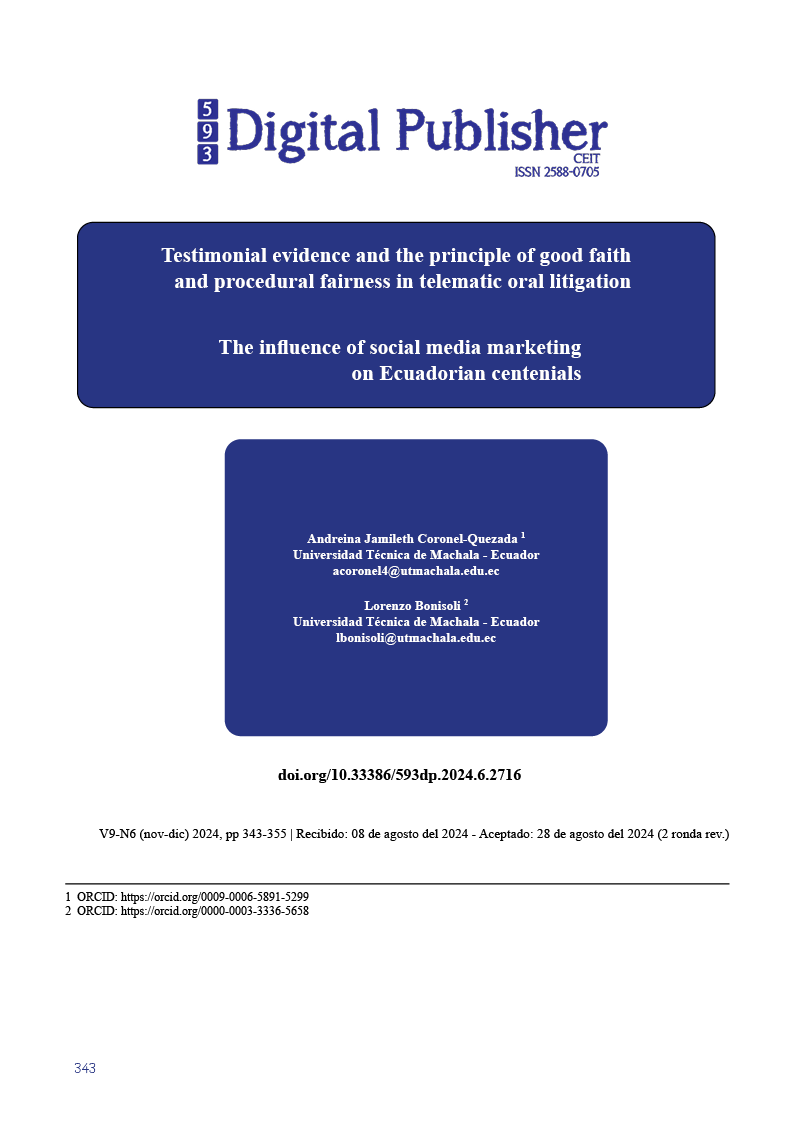The influence of social media marketing on Ecuadorian centenials
Main Article Content
Abstract
The objective of this study is to examine the influence of social media marketing on Ecuadorian Centennials, focusing on the role of influencers. Using a quantitative approach, we analyze how emotional attachment, brand evangelism and influencers' reputation affect the consumption decisions of this generation. A questionnaire was administered to 66 participants, assessing key variables such as purchase intention and perceived influence. The results, analyzed using SEM-PLS, show that emotional connection and reputation significantly influence consumer behavior, providing companies with effective strategies to connect with this audience. This work contributes to the understanding of the behavior of Centennials in the Ecuadorian context.
Downloads
Article Details

This work is licensed under a Creative Commons Attribution-NonCommercial-ShareAlike 4.0 International License.
1. Derechos de autor
Las obras que se publican en 593 Digital Publisher CEIT están sujetas a los siguientes términos:
1.1. 593 Digital Publisher CEIT, conserva los derechos patrimoniales (copyright) de las obras publicadas, favorece y permite la reutilización de las mismas bajo la licencia Licencia Creative Commons 4.0 de Reconocimiento-NoComercial-CompartirIgual 4.0, por lo cual se pueden copiar, usar, difundir, transmitir y exponer públicamente, siempre que:
1.1.a. Se cite la autoría y fuente original de su publicación (revista, editorial, URL).
1.1.b. No se usen para fines comerciales u onerosos.
1.1.c. Se mencione la existencia y especificaciones de esta licencia de uso.
References
Xu, Y., & Chen , Z. (2006). Juicio de relevancia: ¿Qué consideran los usuarios de la información más allá de la actualidad? Mermelada. Soc. inf. Ciencia, 57, 961–973.
Ab Hamid, A., Sami, W., & Sidek, M. H. (2017). Discriminant Validity Assessment: Use of Fornell & Larcker criterion versus HTMT Criterion. IOP Publishing Ltd. https://doi.org/10.1088/1742-6596/890/1/012163
Al Nawas, I., Altarifi, S., & Ghantous, N. (2021). E-retailer cognitive and emotional relationship quality: Their experiential antecedents and. International Journal of Retail and Distribution Management, 49, 1249–1270. https://doi.org/10.1108/IJRDM-07-2020-0239
Alfonso Esteban, A., Delgado Ballester, M. E., y Pelaez, M. J. (2014). Who loves brands? Personal factors that influence the consumer. Revista Española de Investigación de Marketing ESIC, 18(3), 2-16. https://doi.org/10.1016/S1138-1442(14)60002-4
Bagozzi, R. P., & Yi, Y. (1988). On the evaluation of structural equation models. Journal of the Academy of Marketing Science, 16, 74-94. https://doi.org/https://doi.org/10.1007/BF02723327
Bagozzi, R. P., Yi, Y., & Phillips, L. W. (1991). Assessing Construct Validity in Organizational Research. Administrative Science Quarterly, 36(3), 421-458. https://doi.org/https://doi.org/10.2307/2393203
Balanche, D., Casaló, L., & Flavián, M. (2024). Human versus virtual influences, a comparative study. Journal of Business Research, 173. https://doi.org/10.1016/j.jbusres.2023.114493.
Brito Rhor, M. D., Chachalo Carvajal, G. P., & Murray Álvarez, M. G. (2021). Marketing de influencia: análisis de credibilidad e intención de compra. Signo y Pensamiento , 40(78). https://doi.org/10.11144/Javeriana.syp40-78.miac
Carmel, D., Roitman, H., & Yom-Tov, E. (2012). On the relationship between novelty and popularity of user-generated content. ACM Transactions on Intelligent Systems and Technology, 3, 1-19. https://doi.org/10.1145/2337542.2337554
Ceres. (2019). Factores determinantes de la sostenibilidad en una empresa cañicultora del Ecuador. En Revista de Ciencias Sociales (pp. 288-302).
Chen , C. C., & Lin, Y. C. (2018). What drives live-stream usage intention? The perspectives of flow, entertainment, social interaction, and endorsement. Telematics and Informatics, 35, 293-303. https://doi.org/10.1016/j.tele.2017.12.003.
Chu, & Kim. (2011). Determinants of consumer engagement in electronic word-of-mouth (eWOM) in social networking sites. International Journal of Advertising. https://doi.org/http://dx.doi.org/10.2501/IJA-30-1-047-075
Chu, S., & Kim, Y. (2011). Determinants of Consumer Engagement in Electronic Word-of-Mouth (eWOM) in Social Networking Sites. nternational Journal of Advertising, 30. https://doi.org/https://doi.org/10.2501/IJA-30-1-047-075
Chung-Wha, K., Cuevas, L., Chong, S., & Lim, H. (2020). Influencer marketing: Social media influencers as human brands attaching to followers and yielding positive marketing results by fulfilling needs. Journal of Retailing and Consumer Services, 55. https://doi.org/https://doi.org/10.1016/j.jretconser.2020.102133
Cronbach, L. (1951). Coefficient alpha and the internal structure of tests. Psychometrika, 16, 297-334. https://doi.org/https://doi.org/10.1007/BF02310555
Davison, A., Hinkley, D., & Young, G. (2003). Recent Developments in Bootstrap Methodology. https://doi.org/10.1214/ss/1063994969
De La Vega, M. (6 de Agosto de 2023). Estrategias de Marketing con Resultados. Estrategias de Marketung con Resultados: https://marcosdelavega.com/estrategias-de-marketing/
Dijkstra, T. K., & Henseler, J. (2015). Consistent Partial Least Squares Path Modeling. Mis Quarterly, 29, 297-316.
Downie, C. (31 de Mayo de 2016). Blog de Unity. Blog de Unity: https://blog.unity.com/es/news/new-products-and-prices
Dwivedi, A., Johnson, L., Wilkie, D. C., & De Araujo-Gil, L. (2019). Consumer emotional brand attachment with social media brands and social media brand equity. European Journal of Marketing , 53(6), 1176-1204. https://doi.org/10.1108/EJM-09-2016-0511
Ganga S. , D., & Duthler, G. (2019). Relationship management through social media influencers: Effects of followers’ awareness of paid endorsement. Public Relations Review, 45. https://doi.org/10.1016/j.pubrev.2019.03.002.
Ghasemy , M., Teeroovengadum, V., Becker, J.-M., & Ringle, C. (2020). This fast car can move faster: a review of PLS-SEM application in higher education research. Higher Education, 80, 1121–1152. https://doi.org/https://doi.org/10.1007/s10734-020-00534-1
Gutierrez, C., & Rosario, E. (2019). El marketing mix y su relación con el posicionamiento del bazar Ángel Carabayllo,. El marketing mix y su relación con el posicionamiento del bazar Ángel Carabayllo,: https://hdl.handle.net/20.500.12692/40924
Haudi, Handayani, W., Musnaini, Suyoto, Y. T., Prasetio, T., Pital-Oka, E., . . . Cahyono, Y. (2022). The effect of social media marketing on brand trust, brand equity and brand loyalty. International Journal of Data and Network Science, 6(3), 961-972. https://doi.org/10.5267/j.ijdns.2022.1.015
Hudders, L., De Veirman, M., & Nelson, N. (2019). What is influencer marketing and how does it target children? A review and direction for future research. Frontiers in Psychology. https://doi.org/https://psycnet.apa.org/doi/10.3389/fpsyg.2019.02685
Hughes, C., Swaminathan, V., & Brooks, G. (2019). Driving Brand Engagement Through Online Social Influencers: An Empirical Investigation of Sponsored Blogging Campaigns. Journal of Marketing, 83(5), 78-96. https://doi.org/10.1177/0022242919854374
Hwang, & Zhang. (2018). https://doi.org/10.1016/j.ijresmar.2018.04.003
Ibrahim, B., Aljarah, A., & Sawaftah, D. (2021). Linking social media marketing activities to revisit intention through brand trust and brand loyalty on the coffee shop facebook pages: Exploring sequential mediation mechanism. Sustainability (Switzerland), 13(4), 1-16. https://doi.org/10.3390/su13042277
Jöreskog, K. G. (1971). Statistical analysis of sets of congeneric tests. Psychometrika, 36, 109-133. https://doi.org/https://doi.org/10.1007/BF02291393
Keng, B., Voon, H., Jun, J., Lai, Y., Garry Wei, H., & Ai, F. (2023). Social media influencers: An effective marketing approach? Journal of Business Research, 160. https://doi.org/10.1016/j.jbusres.2023.113773
Kim, D., & Kim, H. (2023). Social media influencers as human brands: an interactive marketing perspective. Journal of Research in Interactive Marketing, 17, 94-109. https://doi.org/10.1108/JRIM-08-2021-0200
Kline, R. (2011).
Kozinets, R. V., De Valck, K., Wojnicki, A., & Wilner, S. (s.f.). Networked Narratives: Understanding Word-of-Mouth Marketing in Online Communities. Journal of Marketing. https://doi.org/http://dx.doi.org/10.1509/jmkg.74.2.71
Ladhari, R., Massa, E., & Skandrani, H. (2020). YouTube vloggers’ popularity and influence: The roles of homophily, emotional attachment, and expertise. Journal of Retailing and Consumer Services, 54. https://doi.org/10.1016/j.jretconser.2019.102027
Liao , J., Dong, X., Luo, Z., & Guo, R. (2021). Oppositional loyalty as a brand identity-driven outcome: a conceptual framework and empirical evidence. Journal of Product and Brand Management , 30(8), 1134-1147. https://doi.org/10.1108/JPBM-08-2019-2511
Lou, C., & Yuan, S. (2019). Influencer Marketing: How Message Value and Credibility Affect Consumer Trust of Branded Content on Social Media. Journal of Interactive Advertising, 19 , 58–73. https://doi.org/10.1080/15252019.2018.1533501
Ma, T. J., & Atkin, D. (s.f.). User generated content and credibility evaluation of online health information: A meta analytic study. Telematics and Informatics, 34, 472–486. https://doi.org/10.1016/j.tele.2016.09.009
Makrides, A., M, C., Thrass, & Vrontis, D. (2021). Social media influencer marketing: A systematic review, integrative. Int. J. Consum. Stud., 45, 617–644.
Mishra, A. S. (2021). Exploring COBRAs, its antecedents and consequences in the context of banking brands. International Journal of Bank Marketing , 39(5), 900-921. https://doi.org/10.1108/IJBM-11-2020-0553
Priyanka. (20 de Febrero de 2023). CARMATEC. CARMATEC: https://www.carmatec.com/es_mx/blog/cuanto-cuesta-el-desarrollo-de-una-aplicacion-de-realidad-aumentada/
Rungruangjit, W., & Charoenpornpanichkul, K. (2022). Building Stronger Brand Evangelism for Sustainable Marketing. Sustainability (Switzerland), 14, 2-27. https://doi.org/10.3390/su142315770
Sánchez-Fernández, R., & Jiménes Castillo, D. (2021). How social media influencers affect behavioural intentions towards recommended brands: the role of emotional attachment and information value. Journal of Marketing Management, 37(11-12), 1123–1147. https://doi.org/10.1080/0267257X.2020.1866648
Shah, S. A., Shoukat, M. H., Jamal, W., & Shakil Ahmad, M. (2023). What Drives Followers-InfluencerIntention in Influencer Marketing? ThePerspectives of Emotional Attachmentand Quality of Information. SAGE Open, 13(2), 1-15. https://doi.org/ 10.1177/21582440231179712
Sheth, S., & Kim, J. (2017). Social Media Marketing: The Effect of Information Sharing, Entertainment, Emotional Connection and Peer Pressure on the Attitude and Purchase Intention. GSTF Journal on Business Review, 5, 62-70.
Vrontis, D., Makrides, A., Christofi, M., & Thrassou, A. (2021). Social media influencer marketing: A systematic review, integrative. International Journal of Consumer Studies, 45, 617–644. https://doi.org/10.1111/ijcs.12647
Yejas, A., & Albeiro, D. (2016). Estrategias de Marketing Digital en la promoción de marca ciudad. Escuela de Administración de Negocios(80), 59-72. wwwwwwwwww
Zhang, X., & Choi, J. (2022). The Importance of Social Influencer-Generated Contents for. Sustainability (Switzerland), 14, 2-18. https://doi.org/10.3390/su14116676
Zhang, X., & Choi, J. (2022). The Importance of Social Influencer-Generated Contents for. Sustainability, 14, 2-18. https://doi.org/10.3390/su14116676
Zhang, X., Wu, Y., & Liu, S. (2019). Exploring short-form video application addiction: Socio-technical and attachment perspectives. Telematics and Informatics , 42. https://doi.org/10.1016/j.tele.2019.101243
Zhang, X., y Choi, J. (2022). The Importance of Social Influencer-Generated Contents for User Cognition and Emotional Attachment: An Information Relevance Perspective. Sustainability (Switzerland), 14(3), 2-18. https://doi.org/10.3390/su14116676
Zhuping , L., Duan, J., & Vijay , M. (2020). Dynamics and peer effects of brand revenue in college sports. International Journal of Research in Marketing, 37, 756-771. https://doi.org/https://doi.org/10.1016/j.ijresmar.2020.02.003



